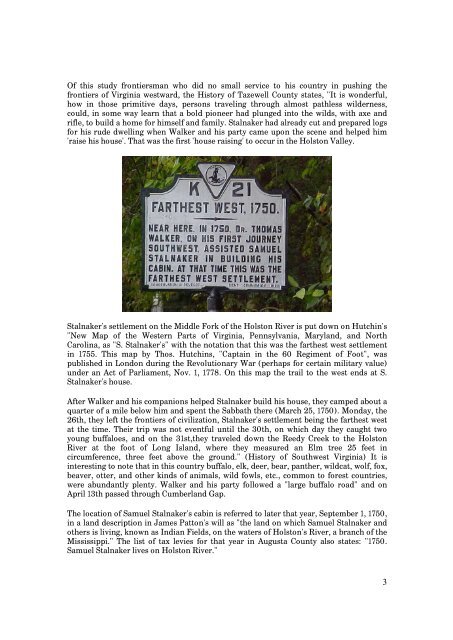Captain Samuel Stalnaker Colonial Soldier and Early Pioneer
Captain Samuel Stalnaker Colonial Soldier and Early Pioneer
Captain Samuel Stalnaker Colonial Soldier and Early Pioneer
You also want an ePaper? Increase the reach of your titles
YUMPU automatically turns print PDFs into web optimized ePapers that Google loves.
Of this study frontiersman who did no small service to his country in pushing the<br />
frontiers of Virginia westward, the History of Tazewell County states, "It is wonderful,<br />
how in those primitive days, persons traveling through almost pathless wilderness,<br />
could, in some way learn that a bold pioneer had plunged into the wilds, with axe <strong>and</strong><br />
rifle, to build a home for himself <strong>and</strong> family. <strong>Stalnaker</strong> had already cut <strong>and</strong> prepared logs<br />
for his rude dwelling when Walker <strong>and</strong> his party came upon the scene <strong>and</strong> helped him<br />
'raise his house'. That was the first 'house raising' to occur in the Holston Valley.<br />
<strong>Stalnaker</strong>'s settlement on the Middle Fork of the Holston River is put down on Hutchin's<br />
"New Map of the Western Parts of Virginia, Pennsylvania, Maryl<strong>and</strong>, <strong>and</strong> North<br />
Carolina, as "S. <strong>Stalnaker</strong>'s" with the notation that this was the farthest west settlement<br />
in 1755. This map by Thos. Hutchins, "<strong>Captain</strong> in the 60 Regiment of Foot", was<br />
published in London during the Revolutionary War (perhaps for certain military value)<br />
under an Act of Parliament, Nov. 1, 1778. On this map the trail to the west ends at S.<br />
<strong>Stalnaker</strong>'s house.<br />
After Walker <strong>and</strong> his companions helped <strong>Stalnaker</strong> build his house, they camped about a<br />
quarter of a mile below him <strong>and</strong> spent the Sabbath there (March 25, 1750). Monday, the<br />
26th, they left the frontiers of civilization, <strong>Stalnaker</strong>'s settlement being the farthest west<br />
at the time. Their trip was not eventful until the 30th, on which day they caught two<br />
young buffaloes, <strong>and</strong> on the 31st,they traveled down the Reedy Creek to the Holston<br />
River at the foot of Long Isl<strong>and</strong>, where they measured an Elm tree 25 feet in<br />
circumference, three feet above the ground." (History of Southwest Virginia) It is<br />
interesting to note that in this country buffalo, elk, deer, bear, panther, wildcat, wolf, fox,<br />
beaver, otter, <strong>and</strong> other kinds of animals, wild fowls, etc., common to forest countries,<br />
were abundantly plenty. Walker <strong>and</strong> his party followed a "large buffalo road" <strong>and</strong> on<br />
April 13th passed through Cumberl<strong>and</strong> Gap.<br />
The location of <strong>Samuel</strong> <strong>Stalnaker</strong>'s cabin is referred to later that year, September 1, 1750,<br />
in a l<strong>and</strong> description in James Patton's will as "the l<strong>and</strong> on which <strong>Samuel</strong> <strong>Stalnaker</strong> <strong>and</strong><br />
others is living, known as Indian Fields, on the waters of Holston's River, a branch of the<br />
Mississippi." The list of tax levies for that year in Augusta County also states: "1750.<br />
<strong>Samuel</strong> <strong>Stalnaker</strong> lives on Holston River."<br />
3


